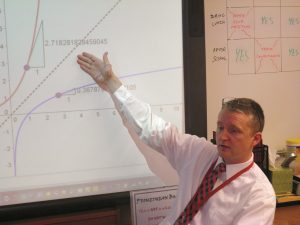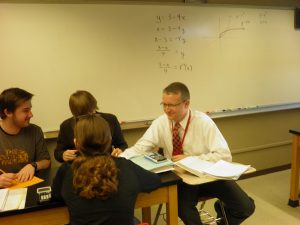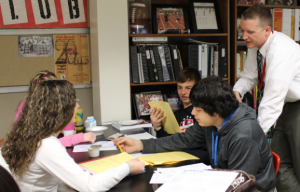Presidential Teaching Honoree Shares Perspective on Statistics Education
Nafeesa Owens, PAEMST Program Lead

Shelby Aaberg teaches in his classroom at Scottsbluff High School in Nebraska.
Photo by Lindsay Augustyn
ASA member Shelby Aaberg’s risk of applying for the Presidential Award for Excellence in Mathematics and Science Teaching (PAEMST) paid off when he won the award, received $10,000 from the National Science Foundation, and traveled to Washington, DC, to meet President Barack Obama in July of 2015.
The mathematics department chair at Scottsbluff High School in Scottsbluff, Nebraska, Aaberg teaches Advanced Placement (AP) Statistics, precalculus/trigonometry, geometry, and problem solving to students in grades 9–12. He credits Significance magazine with providing the rich content he uses for his AP Statistics class.
“If I am to encourage my students to pursue their dreams, I need to back that up by taking risks myself!” –Shelby Aaberg
AP Teaching Philosophy
Aaberg bases his AP teaching on the idea that high-school students’ brains are still developing and the structures that govern rational decision making are not yet fully formed. He says, “If high-school teachers are to teach college-level content to teenagers, it is in the best interest of all involved to do so with safety nets in place.”
For this reason, Aaberg allows his AP students to retake exams for full credit, provided they complete all homework assignments and set up a time to review material with him. Rather than averaging the new test score with the original, Aaberg counts the better of the two. He does not believe in averaging scores and wants to avoid penalizing students for attempting college-level material. He explains, “Averaging the scores makes absolutely no sense. Do we average attempts at the driver’s test? And fail young drivers that pass the sixth time because the other five times were failed attempts?”
Cooperative Assessments
Aaberg is fond of the cooperative assessment technique, in which students are assigned to groups and can use all materials but the internet for the assessment. This type of assessment empowers students to peer teach and help other students who may have missed classwork for extracurricular activities. He gives an example of a cooperative assessment, which can be followed using the steps below:
- Assign students to five groups, with the top five students in the class being assigned one to each of the five groups.
- Provide groups a set time period to work on a problem together as a team.
- Allow students to collaborate between the assigned groups for another set period of time.
- Use a random number generator to select one student to present the solution to the class.
- Allow the audience to disagree or protest the solution provided, and allow the presenter to change his or her answer.
- Provide feedback to the student presenter, if necessary.
- Grade the entire class on the solution the student presents.
Using cooperative assessments in AP Statistics is not the only unique method Aaberg brings to his classroom, however. He also has a unique philosophy on teaching statistics using real-world examples.
The World Outside
Actually, Aaberg would prefer to call it “the world outside of school,” rather than using the term “real-world” in his classroom, as he feels it’s a better representation of what he is looking for. He says, “We look for many consulting opportunities within the community in an effort to show kids not just that mathematics is useful in school, but that it is a tool they can use for problems outside school and in optimizing dilemmas for problems that may seem unsolvable.”
Here are a few examples of the world outside of school exercises he has worked on with his classes:
A school administrator was building a house and wanted his mailbox in a particular location. He bought $600 in materials before finding out his mailbox location proposal was denied. To solve this problem, Mr. Aaberg’s class was asked to propose a new mailbox location that would be approved. His students used Google Earth and GeoGebra to not only find a new path through the neighborhood, but to save the U.S. Post Office a mile per day in driving.
A friend of Aaberg was building a custom car in an area near a municipal water source. The friend needed a 215-gallon oil storage tank made out of cinder blocks. He came to Aaberg’s class in need of a solution, and Aaberg’s students submitted designs for the storage tank that the friend was able to use.
Aaberg posts a collection of additional problems and projects on his blog. He also recently led a Global Math Department webinar called “Bringing the World Outside School Into Your Math Classroom.”
“When the going gets tough … the relationship will dictate how hard a kid tries.”
Advice for New Teachers: Teaching Is a Lifestyle
From his unique classroom activities to his numerous accolades—including PAEMST and Nebraska Teacher of the Year awards—Aaberg has a lot to offer educators who are early in their careers. A love of both statistics and students inspired Aaberg to become a math teacher, and he advises new teachers to build strong relationships with students. “When the going gets tough—and it will, as math class can be a frustrating place of productive struggle—the relationship will dictate how hard a kid tries,” he says.
Aaberg advises new teachers to find a mentor to help with the development of content knowledge. Most of all, he says teaching is a lifestyle and he warns new teachers to not internalize issues from the classroom. He reminds, “It is important for a new teacher to make time for him or herself; put on your own oxygen mask before attending to others!”
What’s Next?
After winning the PAEMST award and taking his wife on the trip to Washington, DC, Aaberg was offered opportunities to provide input to policy at both the state and national levels. One of his short-term goals is to complete his service as president of the Nebraska Association of Teachers of Mathematics. For the long-term, he hopes to finish his doctorate in the next four years. But most of all, when it comes to his plan for what’s next, Aaberg says it best: “My current plan is to continue doing what I enjoy most—teaching high-school mathematics and statistics.”




















Great ideas and advice.